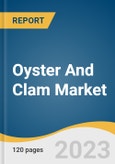The global oyster and clam market size is expected to reach USD 143.28 billion by 2030, expanding at 3.5% CAGR from 2022 to 2030. Growing popularity for premium seafood coupled with rising consumer interest towards health benefits provided by seafood are the major factors driving the demand for the oysters & clam market.
The rise in the number of consumers following a balanced diet is favoring the demand for oysters and clams. As consumers become more health-conscious and environmentally aware, they are increasingly seeking out sustainable and healthy food options. Clams & oysters are seen as a healthy and sustainable protein source and are becoming more popular as consumers seek out healthier and more environmentally friendly food options.
In addition, the globalization of trade has also led to increased competition in the oyster and clam market, as companies globally compete to sell their products worldwide. This has led to improvements in the quality and variety of seafood products available to consumers, as companies seek to differentiate themselves from their competitors. Overall, the globalization of trade has been a key factor in driving the growth of the market in recent years.
In addition, growing awareness among consumers about the importance of sustainable fishing practices and the impact of overfishing on the environment. As a result, many consumers are seeking out seafood products that are sourced using sustainable practices, such as those certified by organizations like the Marine Stewardship Council (MSC) and Aquaculture Stewardship Council (ASC). This has driven demand for sustainably sourced oysters and clams. For example, in 2020, as per a survey by National Retail Federation and IBM, close to 57% of Americans are willing to change their buying habits to reduce the impact on the environment.
Advances in seafood processing and packaging technologies have led to improvements in the quality and safety of seafood products, making them more attractive to consumers. For example, new packaging materials and technologies can help to extend the shelf life of seafood products and reduce the risk of contamination.
The rise in the number of consumers following a balanced diet is favoring the demand for oysters and clams. As consumers become more health-conscious and environmentally aware, they are increasingly seeking out sustainable and healthy food options. Clams & oysters are seen as a healthy and sustainable protein source and are becoming more popular as consumers seek out healthier and more environmentally friendly food options.
In addition, the globalization of trade has also led to increased competition in the oyster and clam market, as companies globally compete to sell their products worldwide. This has led to improvements in the quality and variety of seafood products available to consumers, as companies seek to differentiate themselves from their competitors. Overall, the globalization of trade has been a key factor in driving the growth of the market in recent years.
In addition, growing awareness among consumers about the importance of sustainable fishing practices and the impact of overfishing on the environment. As a result, many consumers are seeking out seafood products that are sourced using sustainable practices, such as those certified by organizations like the Marine Stewardship Council (MSC) and Aquaculture Stewardship Council (ASC). This has driven demand for sustainably sourced oysters and clams. For example, in 2020, as per a survey by National Retail Federation and IBM, close to 57% of Americans are willing to change their buying habits to reduce the impact on the environment.
Advances in seafood processing and packaging technologies have led to improvements in the quality and safety of seafood products, making them more attractive to consumers. For example, new packaging materials and technologies can help to extend the shelf life of seafood products and reduce the risk of contamination.
Oyster And Clam Market Report Highlights
- Slipper oyster held the largest market share in 2022 owing to its easy availability and presence of health benefits
- Pacific cupped oyster as the oyster segment with the highest revenue share in 2022 owing to rising demand for premium oysters among consumers.
- Atlantic surf oyster in the oyster segment is expected to expand at a significant CAGR from 2022 - 2030 . The growth can be attributed to rising consumer demand for ready to eat seafood products
- Asia Pacific is estimated to grow significantly over the forecast period owing to the growing demand for healthy foods in the region.
- Some of the major players in the market include Clearwater Seafoods, High Liner Foods, Pacific Seafood , Taylor Shellfish Farms, Mazetta Company, LLC, Pangea Shellfish Company, Royal Hawaiian Seafood, and Island Creek Oysters
Table of Contents
Chapter 1 Methodology and Scope
Chapter 1 Executive Summary
Chapter 2 Oyster & Clam Market - Industry Outlook
Chapter 3 Oyster & Clam Market: Oyster Type Estimates & Trend Analysis
Chapter 4 Oyster & Clam Market: Clam Type Estimates & Trend Analysis
Chapter 5 Oyster & Clam Market: Form Estimates & Trend Analysis
Chapter 6 Oyster & Clam Market: Regional Estimates & Trend Analysis
Chapter 6 Competitive Landscape
List of Tables
List of Figures
Companies Mentioned
- Clearwater Seafoods
- High Liner Foods
- Pacific Seafood
- Taylor Shellfish Farms
- Mazetta Company, LLC
- Pangea Shellfish Company
- Royal Hawaiian Seafood
- Island Creek Oysters
Methodology

LOADING...
Table Information
| Report Attribute | Details |
|---|---|
| No. of Pages | 120 |
| Published | May 2023 |
| Forecast Period | 2022 - 2030 |
| Estimated Market Value ( USD | $ 108.4 Billion |
| Forecasted Market Value ( USD | $ 143.28 Billion |
| Compound Annual Growth Rate | 3.5% |
| Regions Covered | Global |
| No. of Companies Mentioned | 8 |









